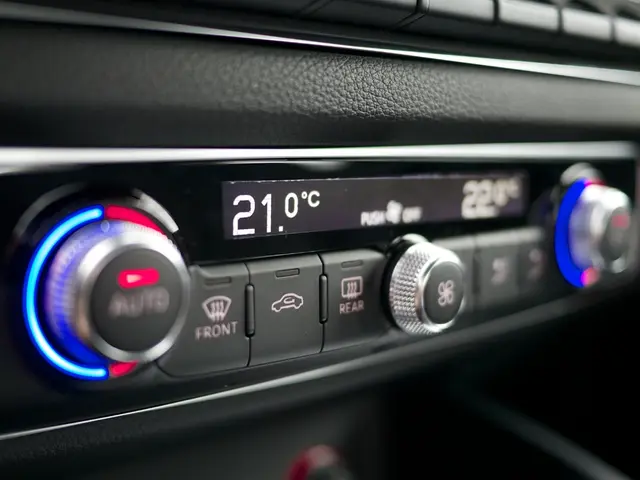AI-Enhanced Air Quality Supervision in HVAC Systems
🔥 The Future of Breathable Spaces: AI Transforms HVAC Systems
Hey there! Let's dive into the exciting world of HVAC and AI, where air quality and healthier living spaces are becoming a reality.
As urbanization continues to grow, our time spent indoors escalates, making indoor air quality (IAQ) a vital concern for our well-being. Traditional HVAC systems can't quite keep up, but AI-powered HVAC systems are shaking things up and bringing fresh air to the table.
IAQ: A Game Changer for Health
Did you know that poor indoor air quality is associated with a variety of health issues, including allergies, respiratory conditions, fatigue, and even cognitive impairment? Common pollutants like CO2, particulate matter, VOCs, mold spores, radon, bacteria, and viruses all pose threats to our health. With the increasing time we spend in schools, offices, homes, and hospitals, it's essential to maintain clean air.
Traditional HVAC Systems: A Missed Opportunity
Traditional HVAC systems concentrate on temperature and humidity control with limited monitoring capacities. These outdated systems lack the flexibility to dynamically respond to changing IAQ conditions, presenting significant shortfalls such as manual operations, inability to detect multiple pollutants, lack of predictive maintenance, and energy inefficiencies.
AI: The Solution to Better Air
AI equips HVAC systems with the ability to learn, adapt, and make independent decisions. Imagine a system that not only monitors air quality in real-time but also adapts to the ever-changing environment, making precise adjustments to ensure clean and safe air within your living and working spaces.
The AI Arsenal
- IoT Sensors: Collect real-time data on temperature, humidity, CO2, VOCs, and particulates.
- Machine Learning Algorithms: Analyze past and real-time sensor data to identify patterns and anomalies.
- Predictive Analytics: Utilize historical trends and advanced predictions to tackle potential future air quality problems.
- Edge Computing: Facilitates local processing of data for quicker responses and reduced cloud reliance.
- NLP: Intuitive interfaces that let users effortlessly request information via voice or text commands.
AI-Powered HVAC Monitoring Workflow
- Data Collection: Precision sensors positioned within HVAC systems or across the facility continuously gather data on multiple IAQ parameters.
- Data Preprocessing: Raw data is filtered, cleaned, and normalized for consistency and accuracy. Missing values are replaced, and data is standardized.
- Anomaly Detection: AI algorithms keep tabs on normal air quality levels and instantly react when abnormalities arise, such as when CO2 or PM2.5 levels spike.
- Predictive Analysis: Leveraging historical data, AI models forecast adverse air quality situations before they become a problem, allowing for proactive measures to be taken.
- Automated HVAC Control: Based on insights and analysis, the AI system autonomously responds by modifying airflow, adjusting filtration, regulating humidity, alerting facility managers or occupants, and more.
Real-World Applications
🏢 Smart Office Buildings: AI-controlled HVAC in commercial spaces personalize heating, cooling, and air quality based on real-time occupant behavior, resulting in increased worker productivity and fewer sick days.
🏥 Hospitals: Precise air filtration and real-time monitoring of bio-aerosols are crucial for healthcare settings to curb infections and keep patients and staff safe.
🏫 Educational Institutions: AI-based HVAC systems ensure optimal CO2 levels within classrooms, benefiting student performance and concentration.
🏠 Residential Complexes: AI-enabled smart thermostats will help homeowners create healthier living environments by optimizing HVAC operations based on local outdoor air quality indicators and indoor activity levels.
The Perks of AI-Based Air Quality Monitoring
- Improved Health and Wellbeing: Precise control of air quality parameters significantly reduces exposure to harmful pollutants and allergens, leading to better health, comfort, and overall well-being.
- Energy Efficiency: AI-powered HVAC systems minimize energy consumption by adjusting operations only when necessary, reducing unnecessary ventilation, filtration, and heating.
- Predictive Maintenance: AI algorithms predict equipment failures, allowing for timely maintenance and minimizing downtime.
- Regulatory Compliance: AI-based systems maintain accurate air quality records, aiding in compliance with health, safety, and environmental regulations.
- Occupant Engagement: Easy-to-use interfaces, real-time alerts, and notifications allow building occupants to participate in maintaining healthy air quality.
Navigating the Challenges
- Data Privacy and Security: Implement robust security measures to safeguard connected systems and IoT sensors from cyberattacks.
- Initial Costs: Prepare for a significant upfront investment in infrastructure, software, and AI-enabled sensors. Look for long-term energy and maintenance savings to offset costs.
- System Integration: Older HVAC systems may require modifications and retrofitting to integrate AI solutions seamlessly.
- Model Accuracy: Ensure high-quality data is used for AI training to produce accurate predictions and maintain system performance.
The Future of AI-HVAC Air Quality Monitoring
- Federated Learning: Multiple buildings collaborate to train AI models without sharing sensitive information, enhancing overall intelligence across various settings.
- Adaptive Learning: AI systems continuously learn and adapt to shifting usage patterns and environmental factors, ensuring long-term performance.
- Integration with Smart City Platforms: AI-based HVAC data contributes to urban health monitoring and environmental policy decisions.
- Emotional AI: Sophisticated systems could analyze human emotions to modulate air quality for improved emotional well-being.
Ready to take your breaths to the next level? Stay tuned for more groundbreaking advancements in AI-powered HVAC systems and the quest for cleaner and safer indoor air! 🌈💨🚀
🔗 Additional Reading:
- Energy Savings Performance Contracting - Boost Efficiency
- Reduce Costs with Smart Energy Management Systems
- Sustainable Energy Auditing - Smart Way to Reduce Waste
- Boost Water and Energy Efficiency for Sustainable Living
- Revolutionary Nanotechnology for Energy Efficiency Gains
- Boost Energy Efficiency in Logistics - Tips for Smarter Savings
- Cloud Based Energy Monitoring - Smarter Solutions for Savings
- Top Carbon Reduction Strategies for Manufacturing Success
- Sustainable Green Roof Systems for Commercial Buildings
- How Green Wall Technology Cuts Energy Costs Efficiently
- Energy Efficiency Revolution with Smart IoT Technology
- Top Solar Battery Storage Solutions for Modern Offices
- Best Energy and Carbon Audit Software for Businesses in 2025
- Sustainability Solutions for Eco-Friendly Hotel Operations
- Solar Power System Design Services for Enterprises
- Energy Optimization in Retail Stores for Maximum Efficiency
- Optimize Energy Use in Restaurants - Expert Solutions
- Efficient, Eco-Friendly Cooling Through AI HVAC Innovation
- AI Solutions to Predict and Prevent Load Shedding
Stay connected! Follow us on our journey to make the world a cleaner and greener place. 🌍🌱😊
Sources:
- https://www.sciencedirect.com/science/article/pii/S2352615714000153
- https://www.dailypioneer.com/2021/epaper/52/52--19-AI-Revolutionizing-Energy-Efficiency-and-Air-Quality-Management-in-Heating-Ventilation-and-Air-Conditioning-Systems-20210427.html
- https://www.academia.edu/84317475/Artificial_intelligence_for_enabling_proactive_predictive_maintenance_in_the_building_sector
- https://www.forbes.com/sites/insights-now/2022/03/11/smart-hvac-and-ai-to-optimize-building-energy-use-and-air-quality-cleaner-greener-air/?sh=6bb9feea4e95
- https://en.wikipedia.org/wiki/Artificial_intelligence
- Machine learning algorithms, when integrated with smart-home-devices and IoT sensors, can enhance AI-powered HVAC systems, allowing for predictive maintenance and precision adjustments to ensure clean and safe air within homes, aligning with the quest for cleaner and safer indoor air spaces.
- The future interplay of technology, gadgets such as AI-enabled smart thermostats, and predictive analytics in residential complexes holds the potential for making homes more energy-efficient and healthier, ultimately improving occupants' comfort and overall well-being.







